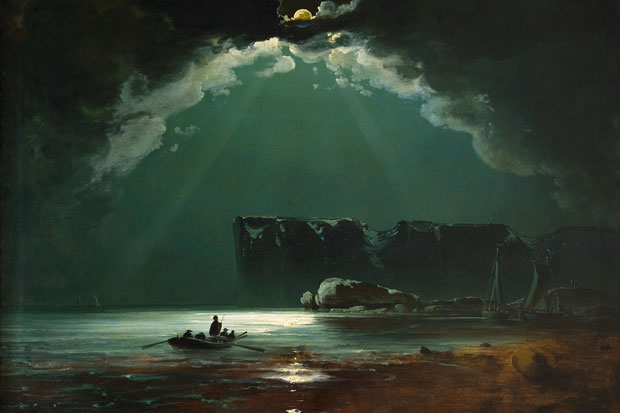You won’t have heard of Peder Balke. Yet this long-neglected painter from 19th-century Norway is now the subject of a solo show at the National Gallery. And it’s an absolute revelation. Walking around, I marvelled at the intensity of a man obsessed with revealing the frozen grandeur and elemental drama dominating his country’s northernmost shores. Like Turner, he was driven by a restless urge to travel, discovering landscapes that enlarged and transformed his vision of the world.
In 1832 he took an arduous sea journey to the far north of Norway, ceaselessly sketching the rugged coast and mountains along the way. His excitement grew as he passed the primal North Cape, and the onset of a hurricane only increased Balke’s avid involvement. On reaching the shore, where he held on tight to a cliff for safety, he was enthralled by the spectacle of the heaving sea hurling itself against rocks. According to his memoir, he never forgot ‘the magnificent sight that manifested itself to my scrutinising gaze’.
The extreme cold must have been daunting, and the National Gallery’s show confronts me immediately with a large, chilling painting of North Cape, where everything — sea, boats, sky and distant mountainous coast — seems in danger of disappearing in an onslaught of snow and ice. Unlike Turner, who revelled in a limitless range of colours, Balke was entranced by the monochromatic battle between extremes of whiteness and dark. He did once attempt to paint Mount Gausta in idyllic shades of blue, but the result compares very poorly with a masterpiece as overwhelming as ‘Lighthouse on the Norwegian Coast’. Painted around 1855, this panoramic canvas focuses on nature at its most alarming. A hapless boat has already been wrecked and swept towards the shore in an explosion of waves. A sailing ship in the far distance looks doomed, lurching in the wind and positioned near a menacing, blood-red strip of sky on the horizon. Above all, though, stormy clouds muster over the isolated lighthouse and threaten it with an implacable blackness.
Perhaps Balke identified, at the deepest level of his imagination, with the vulnerability of this pale, slender lighthouse that refuses to be extinguished by the apocalyptic threat above. People appear very rarely in his work, but his figures are often minuscule and precarious such as the man leading a horse over a worryingly thin bridge. Despite all the visionary verve charging this exhibition with dynamism, Balke himself failed to achieve commercial success. Abandoning his career as an artist, he tried to become a developer, building much-needed houses for the poor. But his radical real-estate experiments faltered as well, and the bearded Balke looks haunted in a photograph taken after he returned to his easel and began painting ‘Mount Stetind in Fog’. He was now 60, and the seascape depicted here could hardly look more bleak and isolated. Even so, the jagged mountain still manages to thrust its peak upwards in the sky, as if defiantly asserting Balke’s own determination to remain intact. (As a child, he endured crippling poverty and it was only his precocious talent that allowed him to escape it.)
Although most of his late work ended up in the attic, Balke was a resilient and audacious artist right up until the moment when, in the early 1880s, he suffered a stroke. Painting on small pieces of cardboard or wood panel, he had concentrated during the 1870s on waterfalls, glaciers, northern lights in ranks of vertical stripes and, inevitably, vessels breaking up in tumultuous sea storms. Maybe he saw himself as a human shipwreck. One of these turbulent little images, ‘The Tempest’ (see p39), is owned by the National Gallery, and the final wall of his show is filled with similarly disturbing scenes.
Balke had always been fresh and economical in his handling of paint, but now he pushes himself to an astonishing extreme. The innovative freedom of his brushmarks looks forward to the German expressionists and even, at times, to Jackson Pollock’s abstract boldness. Balke is a master to be cherished, and we must never again let him slip into oblivion.





Comments